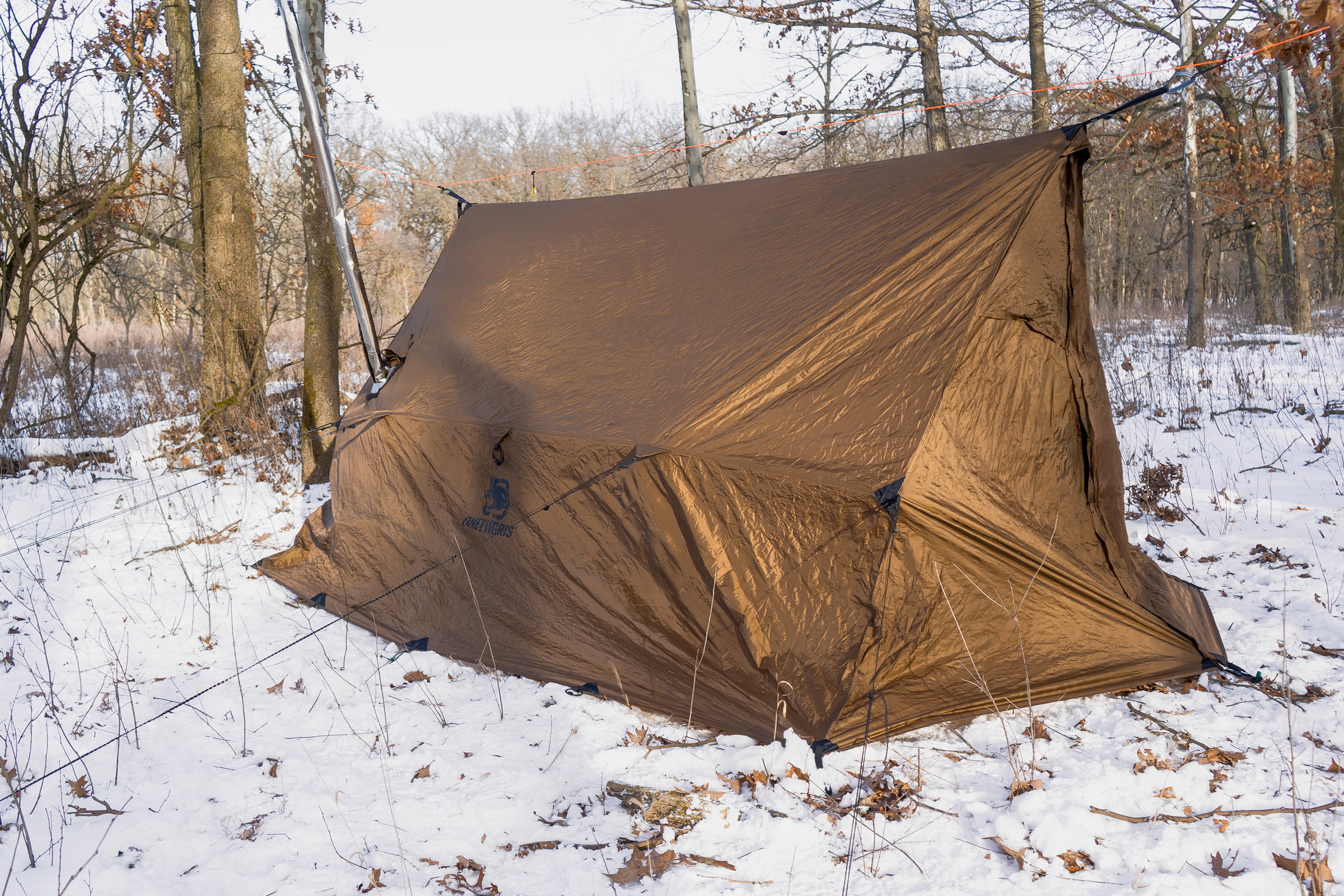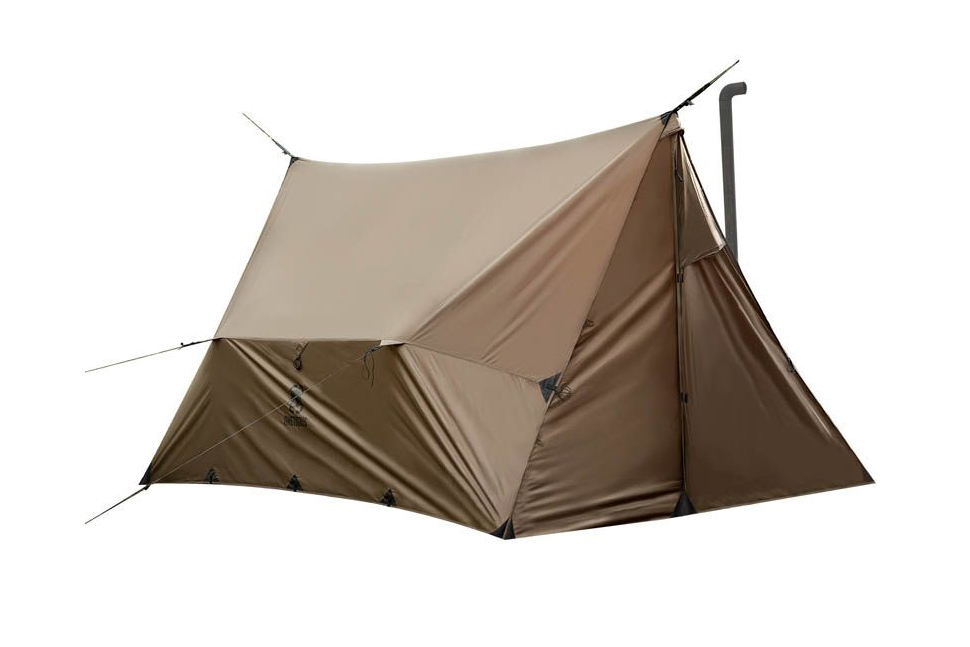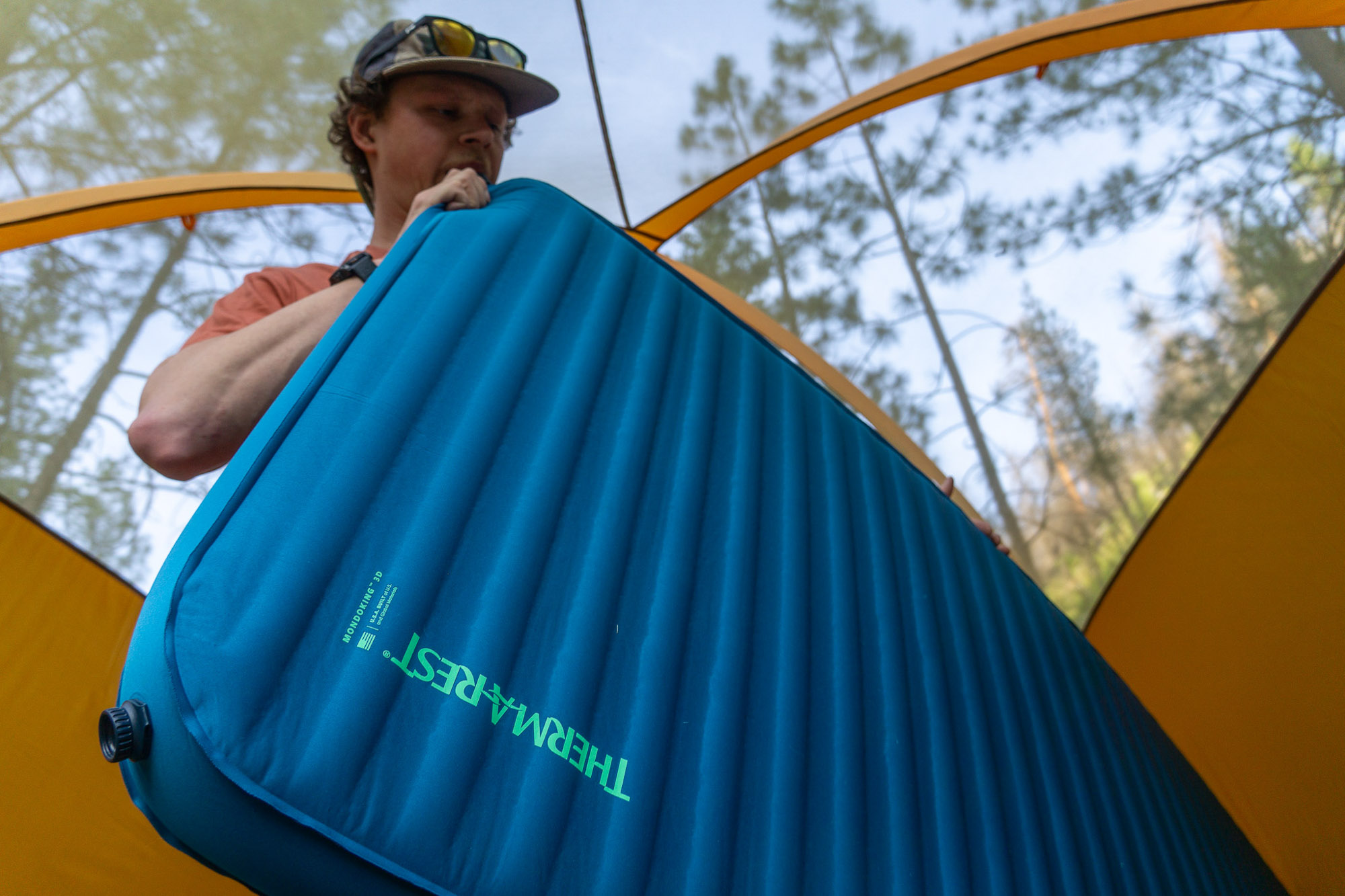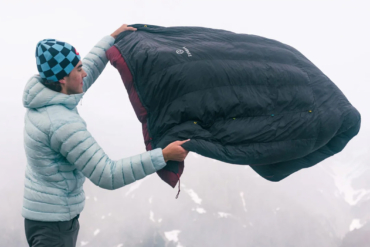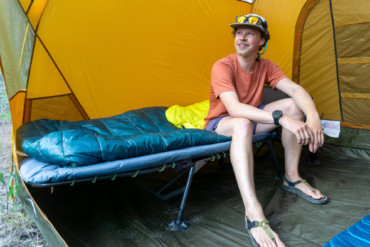My back and my mind have two things in common. They appreciate flexibility, and they obsess over the details. At home, that means morning stretches and nightly articulation of an amorphous blob of pillows and blankets into the perfect cocoon. On the trail, I typically use a tarp and hammock setup.
Granted, tents make morning yoga a bit easier. But they simply don’t offer enough details for my ADHD to hyperfixate over. Caternary tarp or rectangular? Porch mode or tentified? With tarps, there is a form for every trip and every condition, from summer car camping with the dogs to winter island-hopping on a paddle trip.
Naturally, when I saw that OneTigris offered a hot hammock tarp tent (words I had never seen together), I had to test it out. Trading tent poles for trees left it practically ultralight (for a hot tent). Between its generous size, lightweight, and pullouts galore, it seemed versatile enough to be a group shelter for warm-weather trips.
So, I spent a month hauling the ROCDOMUS Hammock Hot Tent by back, car, and canoe, camping beneath it in several configurations through rain, shine, and snowy -10-degree Fahrenheit nights, to see how well it flexed.
In short: The OneTigris ROCDOMUS is a jack-of-all-shelters, but a master of none. As a hot tent, it’s among the lightest and cheapest on the market. But it is also draftier and less heat-efficient than some comparable (but more expensive) hot tent alternatives. For warmer weather, it’s heavier and more complex to set up than most tarps. But it has numerous configurations for camping and can easily shelter multiple people with a smart setup.
- Material: 70D ripstop nylon
- Weight: 6.2 lbs.
- Waterproof rating: 3,000 mm
- Tarp dimensions: 11.1' long, 14.6' wide
- Tent configuration dimensions: 11.1' long 7.8' wide at base, 6.2' tall
- Price: $230
Pros
- Affordable
- Light for a hot tent
- Compatible with most hammock
- Ample ventilation
- Multiple, flexible configurations
- Sized well for solo and group trips alike
Cons
- Subpar stakes
- Complex setup
- Size and asymmetry make heating inefficient
- Indoor rain, if heated after frost is allowed to form
- In high winds, tarp movement can shake stovepipes
OneTigris ROCDOMUS Hammock Hot Tent: Review
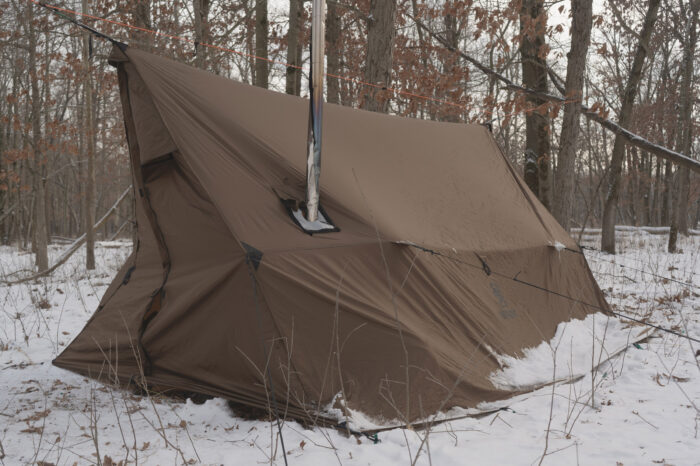
A Different Kind of Hot Tent
Hot tents are shelters designed to accommodate wood-burning camp stoves. When it comes to hot tents, four inherent hitches often steer people away.
First, hot tents tend to be heavy. There are some dedicated ultralight options like the Seek Outside Redcliff Hot Tent. But generally, this style of tent leverages thicker fabrics than most regular mid-level or high-end tents used for camping. Between higher denier fabrics, robust tent poles, and stove jacks usually made from fiberglass and silicon, most hot tents run close to double digits in weight.
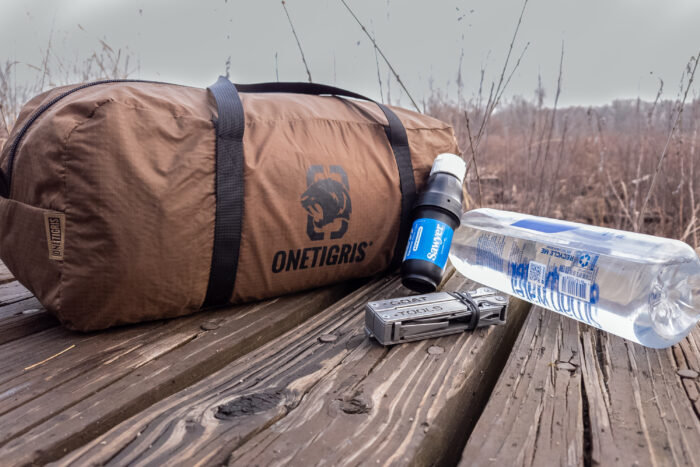
With more robust construction and more specific materials, hot tents also tend to be more expensive. Most good hot tents start at over $300 and run well into the thousands depending on how extravagant or techy they are.
Lastly, while hot tents are theoretically versatile, they aren’t practical in many situations. Higher weight and longer setup times usually mean they’re relegated to multiday cold-weather camping adventures.
The ROCDOMUS tackles all three of these drawbacks by sticking to the simplest, lightest, cheapest, and most versatile sort of shelter: a tarp. The second I saw the $230 price tag, 6.2 pounds claimed weight, and promises of four-season use, I was enamored. But I was also skeptical of how cozy this tent could actually keep me.
Testing in Cold Weather
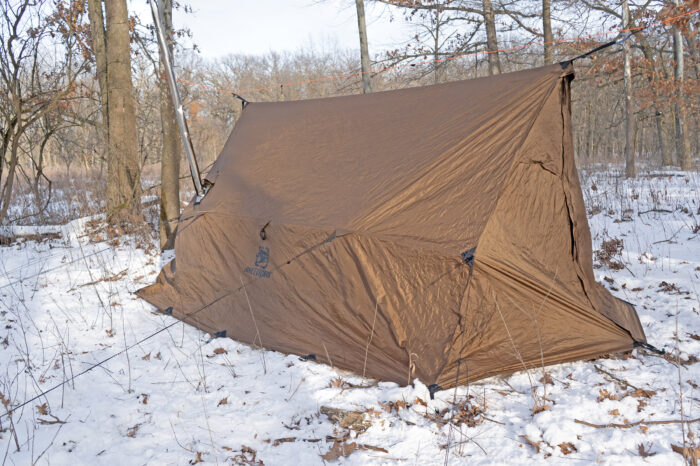
For the ROCDUMUS’s hardest test, I had quite the week lined up. Highs in the 50s. Lows around 10 degrees below zero, with 40 mph gusts. The conditions were perfect for hot tent testing.
The ROCDOMUS is big. A big shelter means a big stove. Larger wood stoves are more versatile than small ones. However, with tent stoves, you either trade cost for weight with steel — or trade weight for compromised heat conduction and nearly double the cost with titanium stoves. Those can run anywhere from $300 to $500.
Fortunately, for its coldest trials, I’d be able to knock out two birds with one stone. To test how hard it was to heat, I grabbed my Seek Outside U-Turn stove. Swapping the sides, I could vary the volume of my stove between around 11L to 15L.
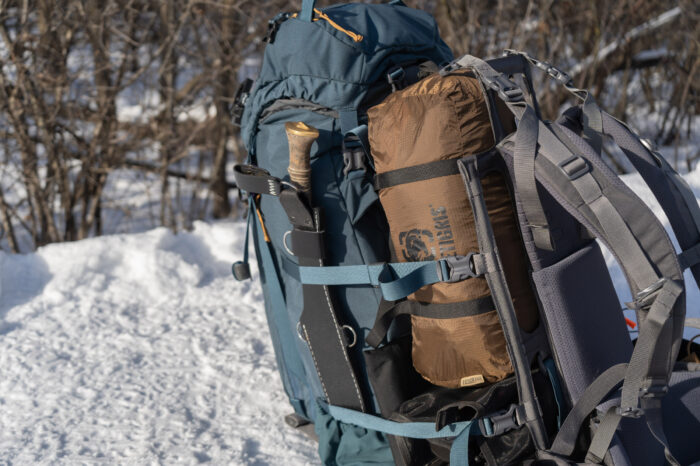
To see how it would carry for someone running a hot tent stove, or packing it for days on, say, a backcountry hunt, I swapped my pack. I took out my usual internal frame. I overloaded the external frame of my trusty Terraframe 65 with the tent, stove, and a few days’ worth of supplementary firewood, and set off for the woods.
ROCDOMUS Hammock Hot Tent Setup
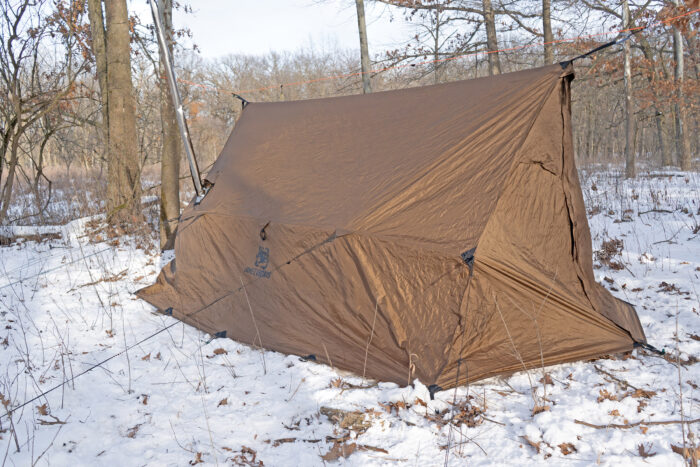
The ROCDOMUS offers four stake-out points along either side with thick shock cord loops. There are four pullouts on each side. And on either end of the topmost points of the tarp, there are two cinchable loops of webbing.
With 10 guylines, the intended setup was clear — run a ridgeline from either loop of the tarp to a tree. However, with such a large and heavy tarp, I found a continuous ridgeline was easier. Simply tension some low-stretch line with prusik loops between two trees, clip the tarp into the prusiks, and slide them taut.
While they added weight, the tarp’s cinchable loops at either end were appreciated. An hour or two in, tarps stretch. On cold nights, pulling a strap to retain the tarp was much easier than stripping my gloves to fumble with prusiks in the dark.
Likewise, while the tarp comes with a lightweight zip bag, I quickly found myself opting to pack it into a “snakeskin” or tarp sleeve. It took a bit of shoving. But a repurposed Hennesy Hammock two-piece snakeskin allowed me to rig the tops and bottoms of the tarp one end at a time, in high winds, without wrestling a shelter-turned-kite.
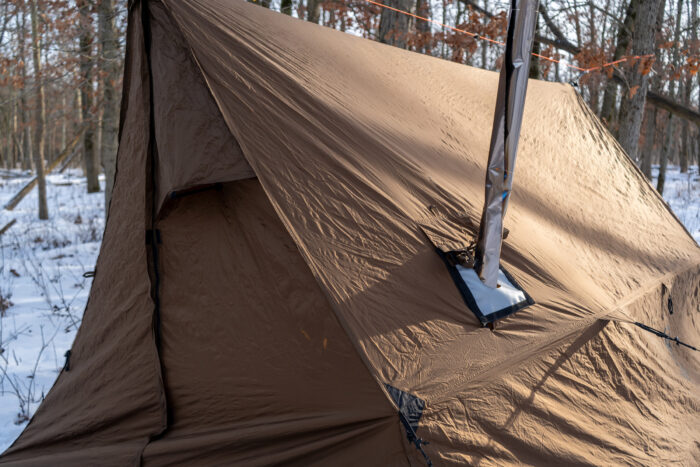
In canopy mode, the hardest part is simply finding enough space at a campsite to string up a nearly 11-by-15-foot tarp. When in porch mode, the doors, which can be either extended or tied up with cinchable loops, offer the option of more protection from wind and rain, or a more open shelter.
In tent mode, particularly for hot tenting, things got interesting. With trial and error, I found that staking the loops of the doors straight down first made all the difference in checking my work.
If the tarp’s bottom was still a few inches off the ground, I’d have a drafty gap between the shelter’s bottom and the ground. In milder weather, this was fine. But it made for a cold night when temps dropped, especially sleeping on a pad or cot. To fix this, I could lower the tent’s height. That way, the heat wasn’t escaping from beneath the walls.
I hadn’t figured out this trick the first night, though. The sun was setting fast, with the temperatures chasing it down into the negatives. And that’s how I melted something I shouldn’t have …
Highs and Lows at Double Below
I always preach, “Never hit the trail with untested gear.” Unfortunately, a busy week and a late start left me setting up camp far too late, with blood sugar far too low. I hung the ridgeline too low. I staked the base too wide and drew the pullouts too taut. That left a drafty gap at the bottom and made the doors hard to zip.
Worst of all, my trembling hands didn’t properly roll back and secure the rain flap that covers the jack for the stovepipe. Eventually, while sitting on a sleeping pad, I noticed the smell of burning nylon and realized the flap was melting against the hot metal.
I only stoked my 11L stove four times throughout the night. The end of the tent nearest the stove was 30 degrees warmer than outside. However, there was a significant variation in temperature within the tent. Between the stove and the end farthest away, there was a solid 15-degree difference in temperature.
Still, for a small stove and drafty setup, it wasn’t too bad.
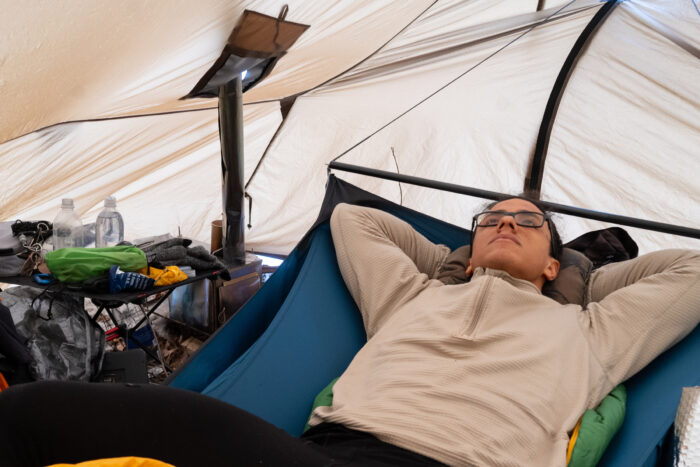
I learned my lessons. I fixed a drafty gap in the bottom for the next few nights of below-zero temps and opted for the 15L stove.
With the stove on high, the stove end of the tent was quickly running 55 degrees warmer than the outside temperature. With the dampeners on, that dropped about 10 degrees on both sides of the tent.
A few times, I let the shelter get cold while I was out on a day hike. With the ROCDOMUS’ sheer surface area, the frost that had formed on the inside walls turned to rain when it thawed.
Luckily, I had my hammock in a snakeskin, a Nomadix bandana to wipe the walls, a roaring fire, and the sun overhead. So, drying it out wasn’t too hard. It wasn’t long before I was sitting in a warm, dry hammock lodge on a 20-degree evening.
Year-Round Versatility
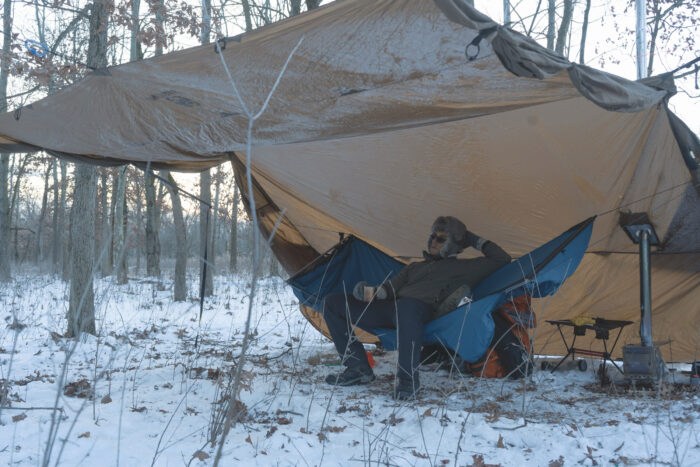
On warmer days, I found myself kicking back beneath the ROCDOMUS in porch mode. My first thought: This shelter is massive. Even as a hot tent, it could potentially sleep four people. In porch mode, I had my hammock tucked away from the rain in the 3.5-by-11-foot pocket of the staked-down side. I could sit and cook steak and eggs beneath the 11-by-7-foot overhang.
Like most hammock tarps, it was easy to put the ROCDOMUS into porch mode with either trekking poles or long branches. Still, 70D nylon is a relatively heavy fabric, and the overhang is large. On windy days, I needed a tauter overhang. I found that tethering the guylines of all five stakeout points to the prusik loops of another ridgeline accomplished this easily.
Given the massive footprint of the tarp, it’s no stretch to say that up to four people could use the ROCDOMUS as the bones of a camp, simply by tossing a mixture of hammocks, cots, or tent inners beneath its auspices. It might be cozy, and you might be sleeping on top of each other (literally). But for a group, at barely over 6 pounds for a relatively beefy denier nylon, that’s a fairly lightweight basecamp.
Quirks, Cons, Features, and Bombs
The ROCDOMUS is far from my first pick for a solo three-season trip. However, as a fan of tarp camping, for bikepacking trips and group outings, it might be my new go-to. Knowing that no matter the weather conditions or what gear they have, I have a shelter that can keep my bike and company alike dry and comfortable, makes it more than worth the weight.
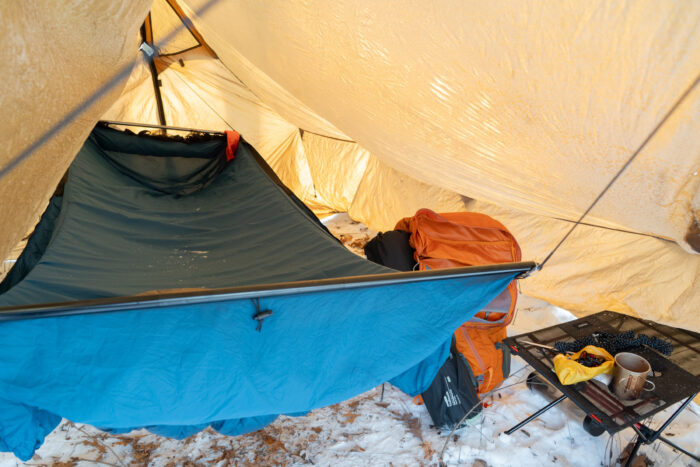
In moderate summer weather, canopy mode could fit many combinations of hammocks, bivies, tent inners, cots, and more for a small group. In shoulder season, porch mode with the back against the wind should do the same.
For hot, humid areas during the kind of driving rain that demands tent mode, ventilation would take a hit with multiple people inside. However, between leaving a gap between the tent and the ground, and propping open the windows at either end, the ROCDOMUS could still offer enough fresh air to get me through a Louisiana summer storm.
The steep temperature difference between the stove and the far sides of the tent could be a concern for group winter camping, as well. The condensation did not evaporate quickly or evenly.
The temperature difference between the sides of the tent could also lead to more infighting than a game of Uno when it comes time to pick your sleeping spot.
There was a lot of playing around required to optimize the ROCDOMUS Hammock Hot Tent’s setup. Ultimately, I settled on an oddly asymmetric configuration. I used all the pullouts on the stove side to keep any high winds from blowing around the tent walls (and by extension, the exceedingly hot stovepipe). But that was only accomplished by using two pullouts on the non-stove side
Cost, Construction, and Quality
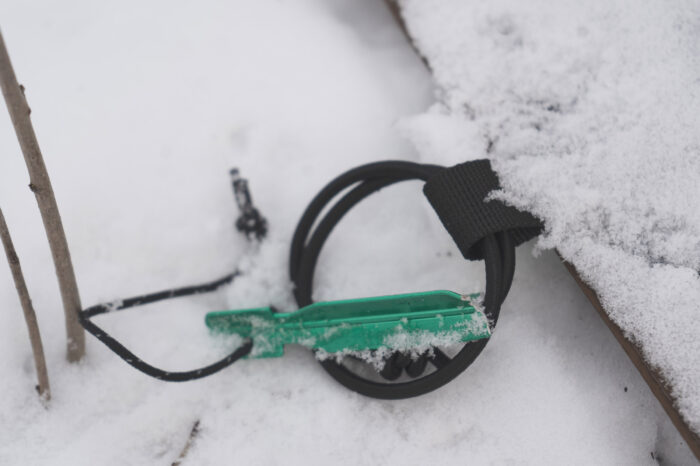
Save for the odd positioning of the stove jack, I couldn’t find a single wayward stitch on the ROCDOMUS. Everything about the tarp’s construction screams quality.
I can’t say the same for the included tent stakes. The pullout loops for several stakes were tied loosely and unraveled when trying to pull the stakes. One day I lightly kicked a stake stuck in frozen ground to loosen it. I was pleasantly surprised at my own strength when I casually sheared it in two.
The guylines were about average for the price point. However, a reflective line and better tensioning devices would be nice touches.
For $230, swapping out the stakes and line was well worth it. The ROCDOMUS Hammock Hot Tent costs less than half as much as some of the most popular hot tents on the market. And it provided the coziest winter hammock camp I’ve ever had. For hammock campers, bikepackers, and group backpackers, the ROCDOMUS is a truly fantastic value.
Accessories and Considerations
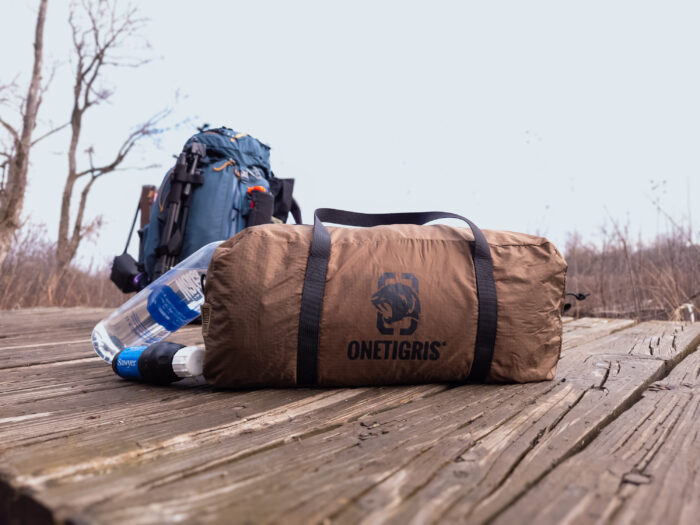
Most of the few things that hold the ROCDOMUS Hammock Hot Tent back have little to do with the shelter at all. They’re the things not standing beside it.
OneTigris doesn’t offer any tent poles long enough to set up the tarp in porch mode. I used another hammock company’s snakeskin to pack and set up the tent. It’s a wonderful summer shelter, but the company doesn’t have a compatible bug net that you can rig to it. However, Onewind has one that could be made to fit. You could use a tent inner or a bug bivy, but OneTigris doesn’t offer any of its own.
No biggie. There is no shortage of workaround and alternative gadgets. However, hammocking powerhouses like ENO, Hennesy, Hammock Gear, Onewind, Dutchware, and Warbonnet do well by being a one-stop shop for everything someone needs to truly optimize hammock camping. A few more accessories could make the ROCDOMUS a more versatile, year-round shelter out of the box.
It’s also worth considering if you’d be able to leverage the ROCDOMUS’ versatility. If you mainly solo camp in places where it doesn’t get particularly cold, where you’d have to pack in your firewood, or mainly prefer ground sleeping — then it might not be the best option.
OneTigris ROCDOMUS Hammock Hot Tent: Conclusion
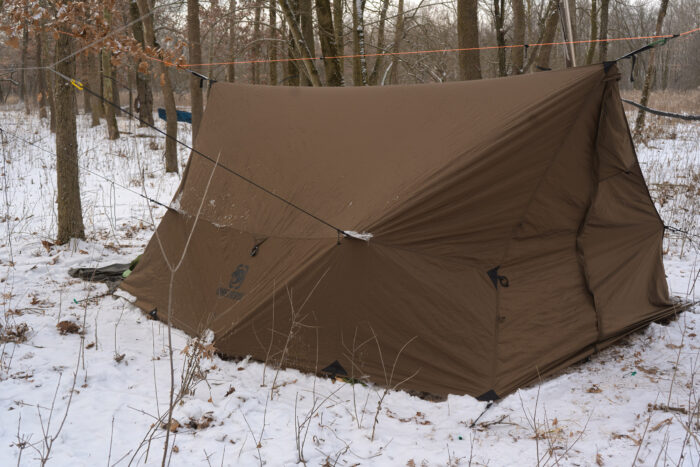
OneTigris’ ROCDOMUS Hammock Hot Tent is an inventive jack-of-all-trades with unrefined versatility. It worked well with different models of hammocks, and it kept me dry and warm during winter outings.
It is quirky and particular to set up. If a person is experienced with hammock camping and tarp tents, I’d absolutely recommend the ROCDOMUS. If, however, they’ve only pitched a freestanding tent a few times, primarily camp solo, and/or aren’t hammock people, I would recommend checking out some of the other options on our Best Camping Tents list.
With a few accessories and experience, though, I could have this Hot Tent set up in all of 10 minutes on any given day. If you know what you’re doing, set up and use are straightforward.
Opting for a hot tent, firewood, and stove means a little less time on the trail. But it was easily the best winter hammock sleep I’ve ever had. For solo summer trips, this tent is overkill. But for those who see the outdoors as a place to bring friends and family, it’s a malleable, spacious, and cost-effective four-season shelter.
So, where does it sit for me? After this winter, in my handlebar bag on my bike. I prefer two wheels to two legs. And for my bikefishing trips, I’ll take a shelter that can keep me, my bike, fishing poles, tripod, and entirely too heavy camp kitchen cozily underwing, while I sleep like a king.
